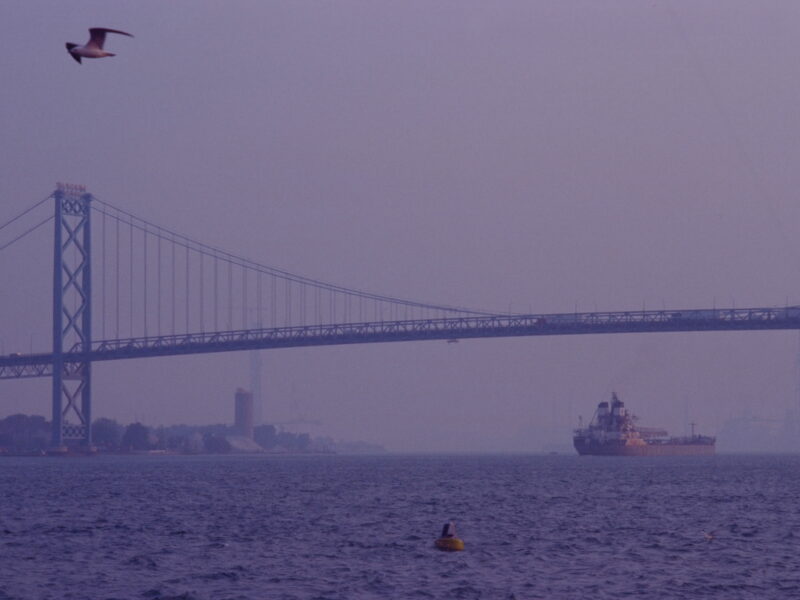Overview:
-In Southwest Detroit, a retiree's report of a petroleum smell to Michigan's environmental regulator underscores the area's ongoing air quality challenges.
-Air quality monitors installed near Marathon Petroleum show elevated total reduced sulfur levels early on April 12.
-Residents are encouraged to report air quality concerns to EGLE.
When a petroleum smell made Ed Gies nauseous on a morning walk to Delray Park just before 8 a.m. on April 12, the 63-year-old decided to report the odor to Michigan’s environmental regulator.
Though no stranger to early morning petroleum smells from working in his garden in Southwest Detroit, this was the first time Gies, a retired manufacturing professional, said he reported an issue to the Michigan Department of Environment, Great Lakes, and Energy.
Gies and a friend walked to the park near Historic Fort Wayne to see progress on the Gordie Howe bridge construction when they turned around. The color indicator on Gies’ mobile, personal air monitor that he brought along the walk quickly turned from green — signifying good air quality — to purple, marking hazardous air.
“The petroleum smell hit me. We stopped immediately and started heading away from it,” Gies said.
He reported the nausea-inducing smell to state regulators the following afternoon. The official noted Gies’ personal information, location, date and time of day, smell description, and said the Detroit office would contact him.

A map that color coded air quality based on Ed Gies’ personal monitor he brought with him on his morning walk to Delray Park on April 12. Screenshot courtesy of Ed Gies.
Southwest Detroit odors behind EGLE complaints
The Michigan environmental regulator could not identify a source for two odor complaints it received April 13, said Josef Greenberg, spokesperson for EGLE.
One resident reported a petroleum odor around 2 1/2 miles to the east-northeast of Marathon Petroleum Corp. that morning, and the same complainant also reported the odor approximately 3 miles to the northeast of the refinery in the early afternoon.
“While Marathon is a possible cause of this odor, the distance and wind direction allow for the possibility that another source (or sources) may have been the cause,” Greenberg said in an email. Data from a Marathon monitoring station indicated the wind was to the north-northeast during the morning and to the north in the early afternoon, he said.
A second complaint of a “sour, smoky, chemical odor” was received about 3 1/2 miles to the northeast of Marathon that morning, Greenberg said, noting the resident did not mention the refinery and that industrial facilities nearer to the complainant were mentioned as a possible cause.
Marathon’s Northeast air quality monitoring station on South Waring Street measures sulfur dioxide, carbon monoxide, total reduced sulfur, and particulate matter with a diameter of 10 microns or less, Greenberg said. Although located close to Marathon, the monitors represent the accumulated contribution of all sources located in the immediate area that emit these pollutants, Greenberg said, and not necessarily the contribution from Marathon alone.
Early on the Saturday that Gies encountered a foul odor, the Marathon Petroleum Corp. air quality monitoring station recorded peak hourly concentrations of 7 parts per billion of total reduced sulfur from 1 a.m. to 4 a.m. The state’s air pollution control rules limit hydrogen sulfide concentrations to 5 ppb beyond a facility’s property line for 2 minutes.
The refinery did not experience any operational issues or releases during this time frame, Marathon spokesperson Amy Nusbaum said in an email.
“In addition, during that time, the northeast monitoring station shows the wind was coming from due north, indicating that the source of the TRS was not from the refinery, which lies to the south and west of that monitoring station,” Nusbaum said. TRS, total reduced sulphur, is composed of hydrogen sulfide and other compounds containing reduced sulfur.
Hydrogen sulfide is removed from oil during the refining process and has a rotten egg smell. At high levels, it can cause convulsions and death, while at lower concentrations, it’s linked to neurological effects and ear, eye, and nose irritation as well as quality of life issues on account of the strong smell.
MORE REPORTING FROM PLANET DETROIT
Climate is adding to Detroit air quality problems: American Lung Association
Detroit’s failing air quality grade in the American Lung Association’s State of the Air Report highlights the impact of climate change and wildfire smoke, as over 77 million people nationwide face unhealthy PM 2.5 pollution spikes.
Detroit faces air quality challenge under new PM 2.5 standard
The Michigan Department of Environment, Great Lakes, and Energy has alerted the EPA that Wayne and Kalamazoo counties fail to meet the updated air quality standards for fine particulate matter, initiating their redesignation as nonattainment areas.
What’s that smell? Southwest Detroiters search for the source of pollution
In the middle of the night, Hubbard Farms resident Elizabeth Luther woke up to a foul odor that smelled like “extremely concentrated natural gas.” Once morning came, she took to the neighborhood’s listserv to see if anyone else smelled the “terrible odor” on the morning of July 19 around 2:45 am. “If it’s in the…
Southwest dense with pollution sources
The odor complaints highlight an everyday problem in Southwest Detroit, where pollution from vehicles and industrial sources on both sides of the Detroit River takes a toll on residents’ health and quality of life.
Major sources of air pollution are scattered across the area, including Marathon, DTE Energy-owned EES Coke Battery, truck traffic servicing the Detroit Intermodal Freight Terminal, and emissions from around 10,000 trucks that cross the Ambassador Bridge daily.
A 2016 study warns these ongoing issues could pose a risk for children in Southwest Detroit, who make up a more significant portion of the population than in other areas of the city.
With still-developing bodies, younger residents are “particularly vulnerable to adverse health effects associated with exposure to air pollutants than other areas of the city,” according to the study.
The Marathon perimeter air quality monitors began operating in 2012, and its public air monitoring database was deployed in 2021 as part of a Supplemental Environmental Project approved by Michigan regulators, according to the company.
Greenberg said the refinery set up the monitoring to comply with its air permits.
Kristy Allen, project manager with Detroit-based air monitoring company Just Air, said an air monitor located across the street from Marathon’s Northeast station recorded two hours where air quality was unhealthy for sensitive groups on April 12.
JustAir’s monitor on Sanders Street and Greyfriars Street measures PM2.5, PM10, and NO2, Aleen said. Between 5:20 a.m. and 7:40 a.m April 12, the monitor recorded PM2.5 measurements above 35.5 micrograms per cubic meter, she said.
Most particulate matter readings between April 12 and 13 were between zero and 9 micrograms per cubic meter, signifying “good” air quality, but about 30 to 40 readings were at moderate levels, Allen said.
The monitor is managed by Green Door Initiative, and does not measure hydrogen sulfide, Allen said.
“PM2.5 and H2S behave quite differently as pollutants, so the JustAir data from this monitor may not be able to be directly linked to an H2S permit violation,” Allen said.
Residents can report an air quality concern from 8 a.m. to 5 p.m Monday through Friday by calling EGLE at 1-800-662-9278; or by calling EGLE’s Detroit District Office at 313-456-4681 for odor concerns originating in Wayne County. Residents can also submit a complaint through EGLE’s new online Air Quality Complaint Form.
For after-hours concerns or emergencies, call the Pollution Emergency Alerting System (PEAS) at 1-800-292-4706.





